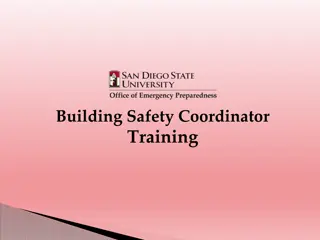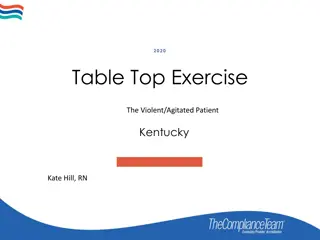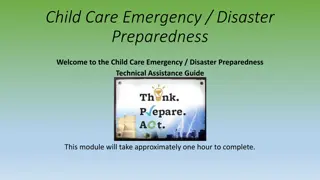Importance of Written Policies and Procedures in Healthcare Emergency Preparedness
Written policies and procedures play a crucial role in the day-to-day operations of healthcare organizations, ensuring that operational requirements translate into successful outcomes. This article discusses the significance of having clear policies and procedures in place, emphasizing the essential elements needed for maintaining access to healthcare services during emergencies. It also addresses the challenges faced in emergency preparedness and the need for providers to be adequately prepared for disasters.
Download Presentation

Please find below an Image/Link to download the presentation.
The content on the website is provided AS IS for your information and personal use only. It may not be sold, licensed, or shared on other websites without obtaining consent from the author. Download presentation by click this link. If you encounter any issues during the download, it is possible that the publisher has removed the file from their server.
E N D
Presentation Transcript
CMS Policy & Procedures Chris Breitbach & Lance Ross
Policies & Procedures Written policies and procedures are critical in the day to day operations of any organization. They influence and determine all major decisions and actions, and all activities that take place within the facility. Together, these documents ensure that operational requirements and guiding principles translate into steps that result in successful outcomes
Important to Remember The requirements do not prescribe or mandate specific technology or tools, nor do they include detailed requirements for how facilities should write their emergency preparedness plans
Important to remember We are not requiring a specific format for the manner in which a facility should have their Emergency Plans documented. Upon survey, a facility must be able to provide documentation of the policies and procedures and show surveyors where the policies and procedures are located.
Purpose of the Rule The rule addresses the three key essentials necessary for maintaining access to health care services during emergencies: Safeguarding human resources Maintaining business continuity Protecting physical resources
Why? Past events have identified that the patchwork of laws, guidelines, and standards related to emergency preparedness in health care falls short of the requirements necessary for providers and suppliers to be adequately prepared for a disaster Because of that, various executive orders and legislative acts helped set the stage for what CMS expects from providers and suppliers with regard to their roles in a more unified emergency preparedness system
Why? Need for additional health care personnel due to patient surge Shortages in medical equipment Challenged accountability of patients Lack of integrated volunteer response Lack of clarity regarding authorities Need for evacuation planning Challenges with emergency funding and payment mechanisms Need for functional triage centers and shelters Challenges in sharing patient information Overall poor communication Failure to identify infectious disease Challenges with isolation setup and triage EMTALA uncertainty PPE shortage Gaps in staff training and education
Policies & Procedures The general components of the policies and procedures requirement include: Develop and implement policies and procedures based on the emergency plan & risk assessment Ensure the policies and procedures address a range of issues including subsistence needs, evacuation plans, procedures for sheltering in place, tracking patients and staff during an emergency Review and update policies and procedures at least annaually
Do your homework CMS Conditions of Participation & Accreditation Organizations Crosswalk
Risk Assessment Hazard vulnerability analysis (HVA) and risk assessment are systematic approaches to identifying hazards or risks that are most likely to have an impact on a healthcare facility and the surrounding community. From the HVA create policies and procedures based on that risk assessment, so documented emergency plans like the Emergency Operations Plan (EOP) or Continuity of Operations Plan (COOP) respond to identified needs.
All Hazards Planning Facilities are expected to develop an emergency preparedness plan that is based on the facility-based and community-based risk assessment using an all-hazards approach. Facilities must document both risk assessments. An example consideration may include, but is not limited to, natural disasters prevalent in a facility s geographic region such as wildfires, tornados, flooding, etc. An all-hazards approach is an integrated approach to emergency preparedness planning that focuses on capacities and capabilities that are critical to preparedness for a full spectrum of emergencies or disasters. This approach is specific to the location of the facility considering the types of hazards most likely to occur in the area. Thus, all-hazards planning does not specifically address every possible threat or risk but ensures the facility will have the capacity to address a broad range of related emergencies.
Planning Considerations Identification of all business functions essential to the facility s operations that should be continued during an emergency Identification of all risks or emergencies that the facility may reasonably expect to confront Identification of all contingencies for which the facility should plan Consideration of the facility s location Assessment of the extent to which natural or man-made emergencies may cause the facility to cease or limit operations Determination of what arrangements may be necessary with other health care facilities, or other entities that might be needed to ensure that essential services could be provided during an emergency.
The Final Rule Increase patient safety during emergencies Establish consistent emergency preparedness requirements across provider and supplier types Establish a more coordinated response to natural and man- made disasters
Important to Remember The requirements do not prescribe or mandate specific technology or tools, nor do they include detailed requirements for how facilities should write their emergency preparedness plans























